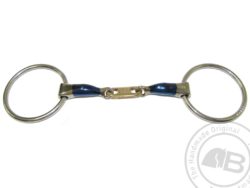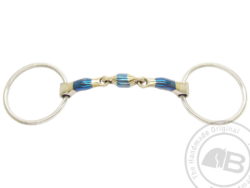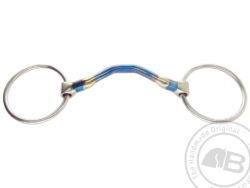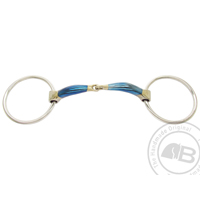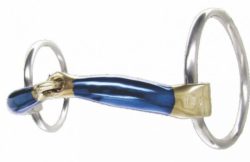Fitting the correct Bomber Bit for your horse or pony
How to find the right bit for your horse…
In this latest article, we look at how to measure, fit and find the correct Bomber Bit for you and your Horse. Here is a comprehensive guide you should follow to find the right bit for your horse’s mouth.
Firstly, you need to make sure your horse has no existing back, neck or mouth pain. Ask an EDT, vet, saddler or physical therapist to assess your horse and eliminate any issues – even the correct bit for your horse will not help behavioural issues linked to pain or discomfort caused by a physical problem.
What mouthpiece do I need?
The second step is knowing what mouthpiece you need. Bombers, having in excess of 20,000 bits on offer, gives you such a wide selection of bits that choosing can be difficult! Here are a few signs that can help you get on the right path:
- If the horse sticks its nose up in the air the moment the reins are taken up, this could be the horse telling you that it is experiencing pain in its mouth. If using a single break snaffle, you could to change to a three-piece bit such as a Control Plate or an elliptical.
- The horse shaking its head probably means that it does not want or accept tongue pressure very well. From the snaffle or control plate, you could go softer to the Happy Tongue, designed specifically to take pressure off the tongue. We stock a wide range of Happy Tongue mouthpieces in our stock, as they are becoming increasingly popular.
- A horse bringing its chin up to its chest in an effort to evade the bit is a sure sign of ‘too much bit for the horse’. Subsequently, this means they are trying to relieve the pressure. The solution is to either ride on a looser rein, or use a softer bit. From the Snaffle one could use the Lock Up or even an Ultra Comfy Lock up.
- The horse that pokes its nose forward, trying to pull the reins out of the rider’s hands in an effort to relieve the pressure of the bit; once again the solution being to use a softer bit. The Ultra Comfy Lock up is always popular!
How do I accurately measure my horses mouth?
Furthermore, a crucial aspect in finding the correct bit is knowing what size you need. Using a bit measure or straight rod, put it in the horse’s mouth and lift it to the correct place in the mouth, and mark the bar on both sides just outside the lip crease. You then measure the distance and see how many millimetres between the marks on the bar. If you are struggling to find something to measure with, we always recommend the wooden spoon!
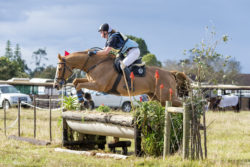 The bit size will differ depending on the type of mouth piece required. The majority of horses are fitted with bits that are too tight and this just adds more pressure points. With a fixed mouth piece, bit the size required is the measured size; with the single and double break bits, this should be the measured size, plus 10 mm, to take into account the way the bits move and fit. In addition to this add 5mm if the bit has a loose ring cheek piece. Nothing additional needs to be added for fixed cheek pieces.
The bit size will differ depending on the type of mouth piece required. The majority of horses are fitted with bits that are too tight and this just adds more pressure points. With a fixed mouth piece, bit the size required is the measured size; with the single and double break bits, this should be the measured size, plus 10 mm, to take into account the way the bits move and fit. In addition to this add 5mm if the bit has a loose ring cheek piece. Nothing additional needs to be added for fixed cheek pieces.
Once you have established the mouthpiece and the width, then you have to establish which cheek piece would be suitable. This is dictated by various aspects, including the discipline the rider is participating in, and the skill level of the rider.
Small horse bits that measure 105mm to 120mm, we actually consider these to be pony bits. This means that they include pony rings and a smaller thickness (B12). From 125mm to 150mm, they include normal rings with a slightly bigger thickness (B14).
However, we do offer a service where you can customise your Bomber Bit, with an average lead time of just 4-6 weeks!
Get in touch today if what you’re looking for is not on-site, and is something you require HERE, or give us a call.
If you need some help picking the cheek piece, read below…
What cheek piece should I be using?
We have put together the actions on the majority of cheek pieces that we stock.
Loose Ring
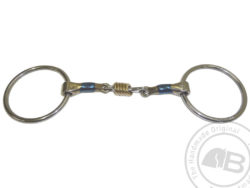 The most popular – the loose ring has much more movement and play than a fixed butt, or cheek. It discourages fixing, blocking and leaning, and encourages mouthing.
The most popular – the loose ring has much more movement and play than a fixed butt, or cheek. It discourages fixing, blocking and leaning, and encourages mouthing.
It allows the mouthpiece more movement, so that it may follow the angle of the tongue, because the angle of the poll and the horse’s overall outline changes through different work etc.
A quality loose ring, correctly fitted, should not cause any nips or rubs. (The Loose Ring Colin Miles is pictured).
Eggbutt
The Eggbutt is a fixed cheek. Everything remains more still in the mouth, and if a horse is lacking in the confidence to stretch into the contact, this may prove extremely beneficial.
Full Cheek (Fulmer)
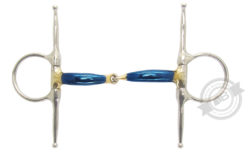 The Fulmer is designed to reinforce the turning aids and gives a more snug fit. If the upper cheek is fixed to the bridle cheekpiece with fulmer keepers, this will fix the mouthpiece in the mouth and also give some poll pressure.
The Fulmer is designed to reinforce the turning aids and gives a more snug fit. If the upper cheek is fixed to the bridle cheekpiece with fulmer keepers, this will fix the mouthpiece in the mouth and also give some poll pressure.
The full cheek is very useful for starting young horses, especially if you do not have access to a safe / enclosed working environment, such as an indoor or outdoor school.
(The Fulmer Lock Up is pictured.)
2.5 Ring (Universal)
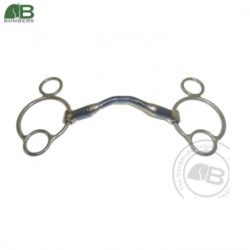 Any extension above the mouthpiece will cause poll pressure (head lowering), any extension below the mouthpiece will give leverage (head raising). Combining the two is generally referred to as a gag action.
Any extension above the mouthpiece will cause poll pressure (head lowering), any extension below the mouthpiece will give leverage (head raising). Combining the two is generally referred to as a gag action.
The Universal is widely used here in the UK.
The gag action is not excessive, and even strong horses generally appreciate this, and respond, as opposed to fighting it.
(The Happy Tongue 2.5 Ring is pictured).
Pelham
The Pelham is a compromise between the Bradoon (Snaffle) and Weymouth (Double Bridle) Curb Bit. The Pelham bit has been used successfully with one rein (employing roundings) over many years. Children and novice riders may have great difficulty riding with two reins.
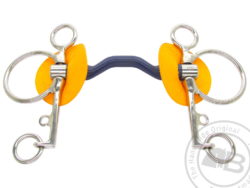 The Pelham exerts pressure on the poll, the curb groove and the mouth. It is available in a variety of mouthpieces. The Pelham should always be employed with two reins for the show ring. Some horses will not jump with a curb action.
The Pelham exerts pressure on the poll, the curb groove and the mouth. It is available in a variety of mouthpieces. The Pelham should always be employed with two reins for the show ring. Some horses will not jump with a curb action.
The curb action occurs when the horse is stretching out the neck prior to take off; contact is needed until one can ‘give’ the reins through the air. It is common practice to run the curb chain through a curb guard, in order to lessen the severity, as an alternative.
(The Polo Pelham 75 Bomber Blue is pictured – this longer length of shank is used for polo.)
Weymouth
It is not very often nowadays that we use a sliding cheek Weymouth. Better results are obtained from the fixed cheek Weymouth as it is stiller in the mouth, so the horse is more accepting and the aids through the rein more definitive. It’s often used in conjunction with a loose ring bradoon.
Alternatively, if you are having trouble deciding or want to get in touch about a custom bit, click here.


